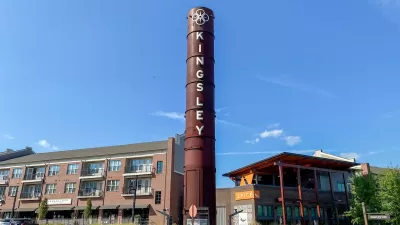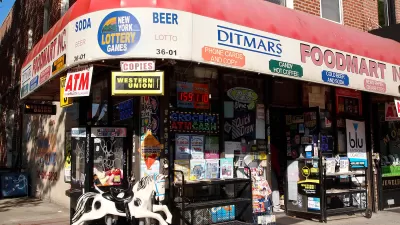Encouraging mixed-use neighborhoods that help reduce vehicle miles driven and put urban amenities within easy walking distance is possible with surprisingly modest policy tweaks.

Walkable neighborhoods and ’15-minute cities’ in the United States could be closer to reality than we might imagine, writes Kea Wilson in Streetsblog. This optimistic view comes in part from research showing that “U.S. homebuyers are hungry to live in neighborhoods where they don't always have to depend on cars to get around” and that, with some “modest policy changes,” U.S. cities could quickly become more pedestrian-friendly.
According to Wilson, “with a few inexpensive tweaks, millions of American neighborhoods may already be far closer to the 15-minute city ideal than policymakers realize.”
A study from Brookings Metro and Replica revealed that “even in the most car-dependent places in America, a lot of people actually do live near a lot of places they should theoretically be able to walk to — and even if those busy nodes aren't reachable on foot, those residents still traveled a shocking 14,500 fewer miles per year on average than their neighbors out in the sticks.” Wilson notes that the researchers defined “activity centers” more broadly, including “standalone mixed-use neighborhoods with a handful of cafes and churches but no bike lanes, or even arterial strip malls where no one would dare travel outside an automobile if given the choice.”
Adie Tomer, senior fellow at Brookings and the co-author of the report, advised that “to get average trip distances down even further, policymakers would be wise to, first, implement zoning reforms that allow Americans to build more activity centers in and around more census tracts, increase the housing supply in the destination-rich neighborhoods they've already got, and limit the construction of car-dependent new developments where there are few to no activity centers nearby.”
Tomer also advises transportation officials to “scrutinize the many reasons residents aren't choosing to visit their closest activity centers right now” and implement policies that support better access and more sustainable transportation modes.
FULL STORY: The Walkable Neighborhoods Americans Want May Be Closer Than We Think

Alabama: Trump Terminates Settlements for Black Communities Harmed By Raw Sewage
Trump deemed the landmark civil rights agreement “illegal DEI and environmental justice policy.”

Study: Maui’s Plan to Convert Vacation Rentals to Long-Term Housing Could Cause Nearly $1 Billion Economic Loss
The plan would reduce visitor accommodation by 25% resulting in 1,900 jobs lost.

Planetizen Federal Action Tracker
A weekly monitor of how Trump’s orders and actions are impacting planners and planning in America.

Wind Energy on the Rise Despite Federal Policy Reversal
The Trump administration is revoking federal support for renewable energy, but demand for new projects continues unabated.

Passengers Flock to Caltrain After Electrification
The new electric trains are running faster and more reliably, leading to strong ridership growth on the Bay Area rail system.

Texas Churches Rally Behind ‘Yes in God’s Back Yard’ Legislation
Religious leaders want the state to reduce zoning regulations to streamline leasing church-owned land to housing developers.
Urban Design for Planners 1: Software Tools
This six-course series explores essential urban design concepts using open source software and equips planners with the tools they need to participate fully in the urban design process.
Planning for Universal Design
Learn the tools for implementing Universal Design in planning regulations.
Caltrans
Smith Gee Studio
Institute for Housing and Urban Development Studies (IHS)
City of Grandview
Harvard GSD Executive Education
Toledo-Lucas County Plan Commissions
Salt Lake City
NYU Wagner Graduate School of Public Service





























